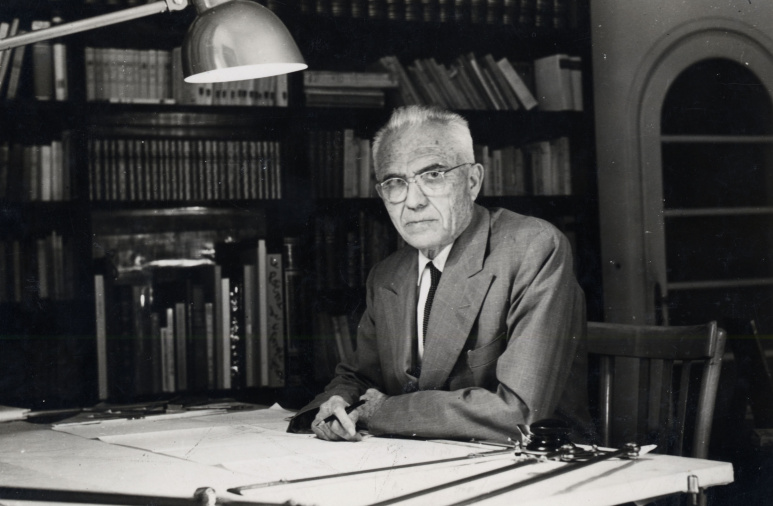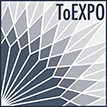Pier Luigi Nervi

Who is Pier Luigi Nervi
Born in Sondrio, in the North of Italy, in 1891 Nervi fascinated by aviation moved to study at the Bologna School of Engineering, one of the country’s most renowned schools, where he met the leading figures in the building industry such as Attilio Muggia, who held , with his company Sacc, the rights to Hennebique’s patented reinforced concrete in Italy. These encounters propelled him into the world of construction, where the properties of reinforced concrete, combining flexibility with strength, appeared to him an endless source of creativity.
Nervi started working in the Florentine subsidiary of Attilio Muggia’s firm. He soon branched out on his own, creating his construction firm with a partner, Nebbiosi, in Rome in 1920, followed by the creation of another firm in 1932 with his cousin Bartoli, also an engineer. In the majority of his projects Nervi will remain faithful to conventional reinforced concrete - a material that can be easily moulded and is resistant to both compression and tension - while limiting the use of prestressed concrete.
Just as fascism as a new political regime was taking over in Italy, Nervi very quickly adopted the modern international style. He renounced eclecticism with its decorative elements added to rational structures, believing in an architecture which was fully in harmony with engineering.
With the Berta Stadium, inaugurated in Florence in 1932, and the airplane hangars in Orvieto and Orbetello (1935-1942) Nervi achieved the international fame which he retained throughout his life.
In all these works, Nervi sought a very refined, formal result, in which every part of the structure is designed precisely according to the internal forces to which it is subject, and the role it plays is clearly demonstrated in the overall project. His keen attention to budgetary constraints led him to introduce his own innovative techniques with an extended use of prefabricated elements, a procedure that will characterize a large part of his subsequent works.
Nervi’s most famous book was published in 1945. Its title - Scienza o Arte del costruire? (Is Building an Art or Science?) - is also a fundamental question. With his work based on its solid design and construction experience and on an intelligent intuitiveness, with a permanent intense attention to the relationships between structure and shape, Nervi’s answer to the question emphasizes the priority of the intuitive moment on the conception of structural architecture, yet it does so without underestimating the importance of the mechanics of structural systems.
He continued a line of research initially developed by pioneer engineers like François Hennebique and subsequently, among others, Robert Maillart in Switzerland. Like his predecessors, Nervi was both designer and constructor, being involved in every part of the building process and blending the art and science of building.
Over his long career, his work encompassed at least six fundamental activities: design, drawing, computation, modeling, writing and teaching.
From his earliest important works, Nervi assessed the structural reliability of most of his projects during their final design phase using reduced-scale models besides statical calculations. This happened in the frame of a long-lasting cooperation along more than three decades with Guido Oberti (1907-2003) and the ISMES laboratories in Bergamo.
Nervi’s first magnificent works were a stadium built in Florence in 1930 and a series of hangars with an area of 4,000 sqm each, built between 1935 and 1940. In all these works, Nervi sought a very refined, formal result, and his keen attention to budgetary constraints led him to introduce his own innovative techniques with an extended use, especially in the last hangars, of prefabricated elements, a procedure that will characterize a large part of his subsequent works.
After the war Nervi designs and builds some of his most relevant works for industrial and civil buildings (Pirelli skyscraper in Milan with Gio Ponti, Audience Hall in the Vatican), exhibition halls and sport structures, in particular in connection with the 1960 Olympic Games in Rome. Since the fifties he becomes the most important Italian designer at the international level with works in Europe (UNESCO building in Paris), North and South America (Bus terminal in New York, St. Mary Cathedral in San Francisco, Victoria Tower in Montreal, Italian Embassy in Brasilia, etc.), and in Australia (Australia Tower in Sidney).
In Turin Nervi realized three of his best-known structures – the two Exhibition Halls for Torino Esposizioni built between 1948 and 1950 and the Palazzo del Lavoro in 1959 – as well as several industrial buildings for Fiat in Mirafiori (Fiat factory, 1954-55; suspended water tank, 1963), for Cromodora in Venaria (1966) and for the local transport authority (Tram depot, 1954).
As an engineer, he was representative not only of the Italian school, but also of the modernist architecture, which, at that time, was spreading throughout the world. A faithful follower of the CIAM (Congrès Internationaux d’Architecture Moderne), in 1952 he was entrusted, together with Marcel Breuer and Bernhard Zehrfuss, with the project for the UNESCO headquarters in Paris, a building that became a kind of manifesto. From the mid of the fifties he designed and built his most relevant projects for industrial and civil architecture, exhibition halls and sport structures, in particular in connection with the 1960 Olympic Games in Rome.
He has been characterized as having the daring of an engineer, the imagination of an architect, and the practicality of a businessman. Nervi and the Nervi & Bartoli developed an organisation which had no equivalent on one hand, there was his studio and, on the other, his building firm where the great Italian tradition of craftsmanship was put to the service of prefabrication and large-scale production. This family business, where three of his sons after 1961 worked as well (Antonio and Vittorio as architects and Mario as engineer), prospered on every continent until the death of Pier Luigi in 1979.
